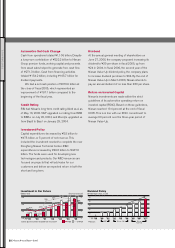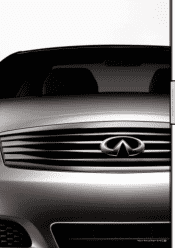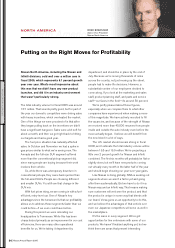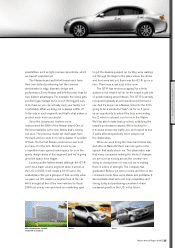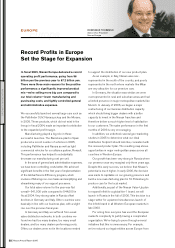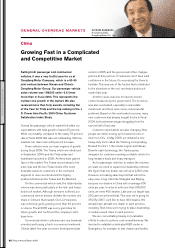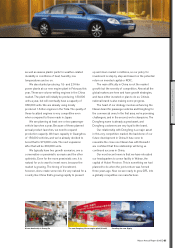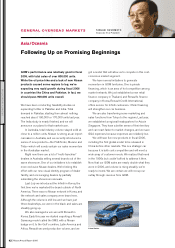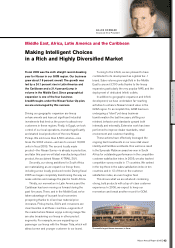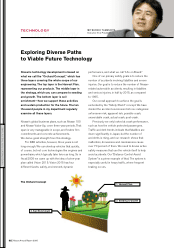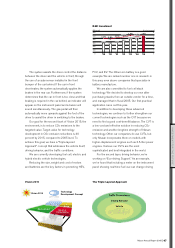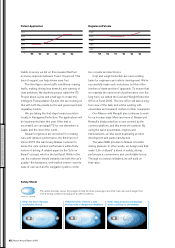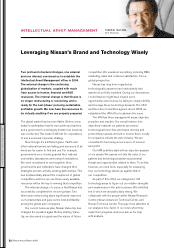Nissan 2006 Annual Report Download - page 42
Download and view the complete annual report
Please find page 42 of the 2006 Nissan annual report below. You can navigate through the pages in the report by either clicking on the pages listed below, or by using the keyword search tool below to find specific information within the annual report.
GGOOMM
Selling both passenger and commercial
vehicles, it was a very fruitful year for us at
Dongfeng Motor Company, which is a 50-50
joint venture between Nissan and China’s
Dongfeng Motor Group. Our passenger vehicle
sales volume was 158,000 units—2.6 times
more than in fiscal 2004. This represents the
number one growth in the market. We also
received more than forty awards, including Car
of the Year for Tiida and the top ranking in the J.
D. Power Asia Pacific 2005 China Customer
Satisfaction Index Study.
Overall, the passenger vehicle market fell within our
expectations, with total growth of about 25 percent.
While very healthy, compared to the nearly 70 percent
rate of fiscal 2003 that was not outstanding. Still, few
markets can claim even a 20 percent increase.
Three vehicles were our main engines of growth
during fiscal 2005: The Teana, which we introduced
in September 2004, and the Tiida sedan and
hatchback launched in 2005. All three have gained
favor in the market. The Teana moved ahead of its
main rival, and the two Tiida models offer some
desirable values to customers in the mid-sized
segment. In June we introduced the Sylphy,
positioned between the Teana and the Bluebird.
On the commercial vehicle side, the total industry
volume was down, particularly in the mid- and heavy-
duty truck market. Although everyone suffered, our
commercial vehicle division did take the number one
share in China in that market. Our LCV business
was extremely good, growing more than 40 percent
in volume. Fiscal 2005 was a very good step for
future growth, and confirmed the company’s solid
base here.
Commercial vehicle customers are very business-
oriented, and buying a truck is a serious investment.
China’s latest five-year economic development plan
ended in 2005, and the government often changes
policies at this juncture. If customers don’t have solid
confidence in the future, it’s very natural for them to
hesitate. This was one of the factors that contributed
to the slowdown in the mid- and heavy-duty truck
market last year.
Another cause was due to macroeconomic
control measures by the government. The economy
was also overheated, especially in real estate
investment, and there were some environmental
problems. Based on the overheated economy, many
new customers had already bought trucks in fiscal
2004, but businesses began struggling from the
second half of last year.
Customer expectations are also changing. Now
people are either moving up to heavier trucks or
down to LCVs. In May 2006, we released a new
heavy-duty truck called the Tianlong. Incorporating
Renault Trucks’ 11-liter diesel engine and Nissan
Diesel’s cabin technology, the Tianlong was
designed for customers seeking a reliable vehicle for
long-distance hauls and heavy transport.
As for passenger vehicles, to realize the volumes
we want, we need to expand our dealership network.
We figure that one dealer can sell up to 2,000 units.
However, increasing sales beyond that will not be
easy even in big cities like Shanghai and Beijing,
because our dealers in China sell on average 800
units per year. In order to sell more than 300,000
units, we need 400 dealers. Last year our target was
250, and we achieved that. This year, we’re going for
350. By 2007, we’d like to have 400 dealers. We
already have at least one dealer in each province,
including Tibet. Now we’re trying to place dealerships
in medium-sized cities in each province.
We are concentrating heavily on localization
efforts in order to achieve cost competitiveness. We
decided to establish a dedicated R&D center in
Guangzhou, for example, to test chassis and bodies,
Nissan Annual Report 2005
40
GENERAL OVERSEAS MARKETS
Growing Fast in a Complicated
and Competitive Market
KATSUMI NAKAMURA
President & CEO,
Dongfeng Motor Co., Ltd.
China
GROWTH MOMENTUM


